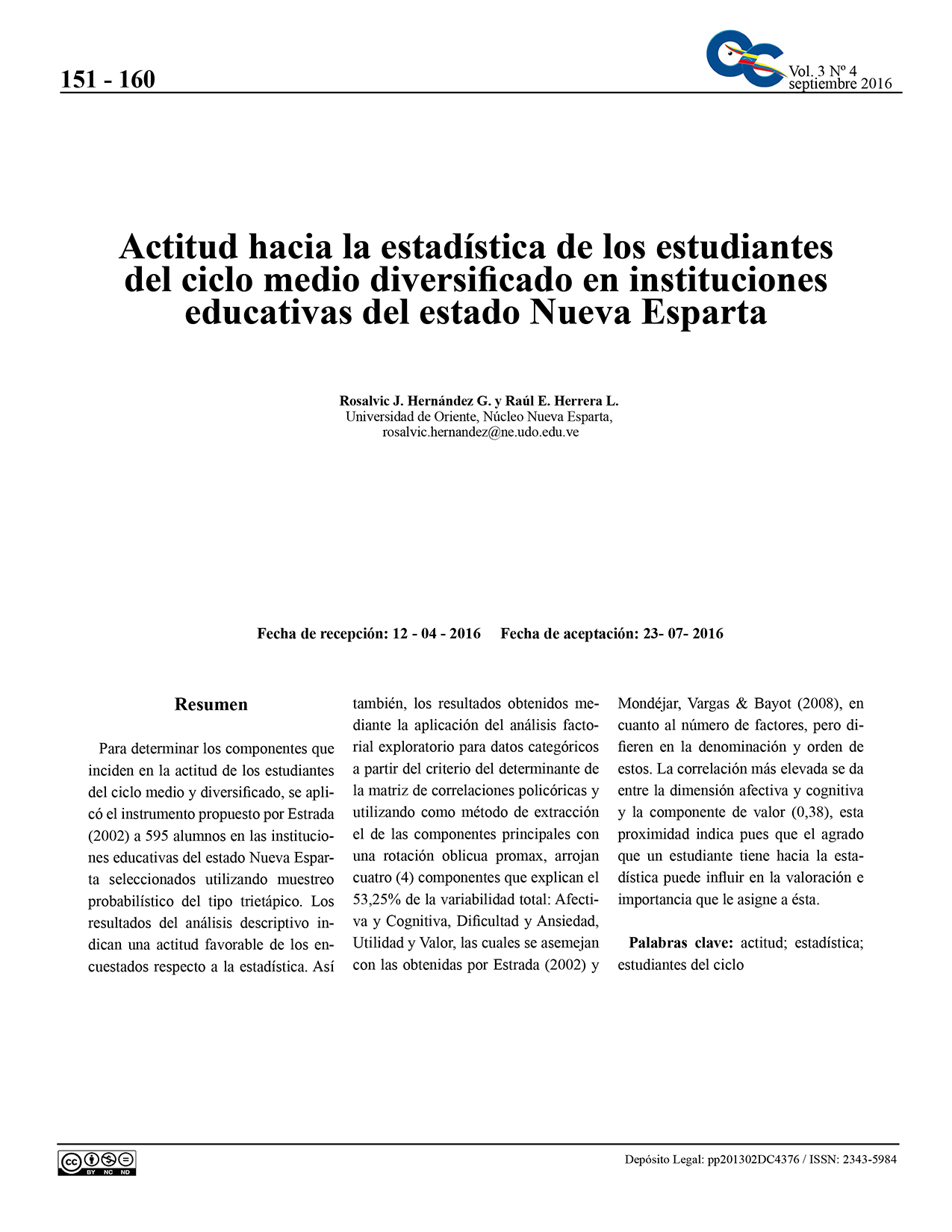Attitude toward statistics of middle cycle students diversified in new state educational institutions Sparta
Keywords:
attitude, statistics, students of the cycleAbstract
To determine the components that affect the attitude of students in the middle and diversified cycle, the instrument proposed by Estrada (2002) was applied to 595 students in the educational institutions of Nueva Esparta state selected using probabilistic sampling of the three-stage type. The results of the descriptive analysis indicate a favorable attitude of the respondents with respect to statistics. Likewise, the results obtained through the application of exploratory factor analysis for categorical data from the criterion of the determinant of the polychoric correlation matrix and using the main components as an extraction method with an oblique promax rotation, yield four (4) components that explain 53.25% of the total variability:Affective and Cognitive, Difficulty and Anxiety, Usefulness and Value, which are similar to those obtained by Estrada (2002) and Mondéjar, Vargas & Bayot (2008), regarding the number of factors, but they differ in the denomination and order of these . The highest correlation is between the affective and cognitive dimension and the value component (0.38), this proximity indicates that the pleasure a student has towards statistics can influence the assessment and importance assigned to it.
Downloads
References
Estrada, M. (2002). Análisis de las actitudes y conocimientos estadísticos elementales en la formación del profesorado. Tesis Doctoral. Barcelona, España. Universidad Autónoma de Barcelona. Disponible desde Internet en: http://tdx.cat/bitstream/ handle/10803/4697/maer1de3.pdf?sequence=1.
Mondéjar J., M. Vargas A. Bayot. (2008). Medición de la actitud hacia la estadística de los procesos de estudio. Revista Electrónica de Investigación Psicoeducativa, vol. 6 (3): 729-748.
Fernandez P., A. Pinela, C. Borges, F. Silva L. Pinto. (2010). La evaluación de la actitud de los futuros profesionales hacia la estadística: Un análisis multivariante. XIV Congreso Internacional de Investigación en Ciencias Administrativas realizado en Monterrey, México: ACACIA.
Bazán J. A. Aparicio. (2006). Las actitudes hacia la matemática-estadística dentro de un modelo de aprendizaje. Revista de Educación de la Pontificia Universidad Católica del Perú, vol. 15 (28): 7-20.
Estrada A., C. Batanero J. Fortuny. (2004). Un estudio comparado de las actitudes hacia la estadística en profesores en formación y en ejercicio. Enseñanza de las Ciencias, vol. 22 (2): 263-274. Auzmendi E. 1992. Las actitudes hacia la matemática-estadística en las enseñanzas medias y universitarias. Bilbao, España: Mensajero.
Méndez D. F. Macía. (2007). Análisis factorial confirmatorio de la escala de actitudes hacia la estadística. Cuadernos de Neuropsicología, vol. I (3): 337-345.
Blanco A. (2010). Creencias de autoeficicacia de estudiantes universitarios: un estudio empírico sobre la especificidad del constructo. Revista Electrónica de Investigación y Evaluación Educativa, vol. 16 (1): 1-28.
Morales P., B. Urosa A. Blanco. (2003). Construcción de escalas de actitudes tipo likert, una guía práctica. Madrid, España: Cuadernos de Estadística La Muralla, S.A. y Editorial Hespérides. Hair J., R.
Anderson, R. Tatham W. Black. (1999). Análisis multivariable. (5ta. ed.). Madrid, España:Prentice Hall.

Downloads
Published
How to Cite
Issue
Section
License

This work is licensed under a Creative Commons Attribution-NoDerivatives 4.0 International License.







